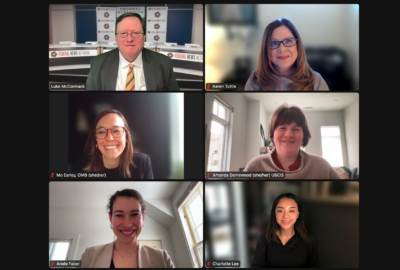Insight by Granicus
How agencies are ‘reaching people where they are’ through effective CX communications
Charlotte Lee, strategic lead for CX and innovation at Granicus, says effective communication is the key to better customer experience in government.
Federal agencies sent more than 150 million text messages and about 12 billion emails to the American public in 2023.
The federal government is making digital communication the foundation of its customer experience strategy, and reaching out to the public through its preferred channels.
The Office of Management and Budget, in its recent guidance on delivering a “digital-first public experience,” said a majority of the public accesses government services online, and that a growing segment of that traffic comes from mobile devices.
Charlotte Lee, strategic lead for CX and innovation at Granicus, says agencies are sending an “enormous” volume of information to their customers, and should take a careful look at whether those messages are getting through to people.
“When you tie it together, is it worth it? Should we be sending all that information?” Lee said. “We’re asking that [they] consider the proactivity of communications as a key factor in CX and transformation management over time, rather than making it the afterthought and only seeing it as these accumulated numbers.”
While agencies designated as High-Impact Service Providers are setting a higher standard for customer experience across the federal government, Lee said a critical, and sometimes overlooked step, is building public awareness of those government services.
“Even if we’re working so hard in the background to improve customer experience and user experience, what actually gets communicated is what really matters. If I don’t know about it, I’m not aware of it, did the digital service exist? If I am on your website, and I’m trying to see if I trust this, what are we doing to help convey that trust?”
Improved communications come with a significant, but sometimes intangible return on investment.
In many cases, effective communications keep individuals up to date on the status of their service or application, and reduces the number of calls agencies have to respond to.
“If you send me a proactive text message about the status of my application, I likely won’t call you at your call centers,” Lee said.
Effective, empathetic communication as part of an agency’s customer experience also builds public trust in government institutions. Lee said that trust is critical to getting some individuals to sign up for government services or benefits.
“There’s a fear and knowing, ‘Should I be giving this information?’” Lee said. “In that moment, where someone is deciding to either take the action or enroll into the program, have we said anything that might change their minds, or help guide their journey, or manage their expectations that would result in that behavior?”
Agencies are relying on text messages and email in many cases to reach out to underserved and at-risk populations, including individuals experiencing homelessness.
“With digital communications, it’s about reaching people where they are. A lot of times, people change their physical addresses more often than email addresses. The same goes with phone numbers, too. Increasing accessibility comes from anywhere, anytime,” Lee said. “Digital communications is the minimum we should be considering in terms of serving underserved communities.”
Building trust becomes especially valuable when the federal government is responding during an emergency or disaster.
“It seems like a nice to have, but when there is a crisis, and you need people to listen, you’re going to want them to listen,” Lee said. “And right now, we live in a very interesting era of information. Part of the government’s primary role is to be the conveyor of the most accurate and most guiding information.”
Lee said effective communication also gives agencies an opportunity to better understand some of the “indivisible burdens” that prevent individuals or communities from knowing about a particular service, or what prevents them from signing up.
“One of the reasons I’m so passionately out there about CX and communications is because it alleviates anxiety and alleviates the burden of knowing,” Lee said. “As we think about the development of applications of digital experience, we should consider what about these unseen parts of the journey, that don’t start at the website — that don’t start assuming awareness, that don’t start assuming someone has the time, the capability and the comprehension to get through it, even if they decide to do it.”
As agencies shift more of their customer-centric services online, Lee said the public increasingly expects the government to send personalized or customized messages — rather than send the same boilerplate message to everyone.
“Subscriber rates, click rates and open rates start to link together with how relevant we are. How many people find what we say important and interesting and are engaging with it?” Lee said. “When you start measuring things like that, you can actually start to segment the population. Alright, like these people have or haven’t engaged with our communications. So perhaps we can do a more customized or personalized approach that would reach them.”
Lee said agencies, with some effort, can often tailor their outreach using the data and technology they already have.
“Agencies have a lot of technology, they have a lot of assets that they’ve accumulated, in terms of tools and websites. If we can apply strategy to them and reuse the data that we already have from those things, and create a persona that we are responding to, based on the assets and data we already have, we might have a quicker outcome that is measurable in terms of what the customer actually experiences,” she said.
Regardless of where agencies are in their CX journeys, Lee said the path to improvement starts with identifying ways that a better customer experience links back to the agency’s mission.
“The impact of that can be directly translated to how many people showed up to receive vaccinations or signed up for this program or was able to make the deadline,” Lee said. There’s so many brilliant people working on CX right now, who don’t have a lot of resources, who may be feeling like, ‘We’re not going to be able to make any impact or meaningful impact for a really long time or without any money.’ I would just ask them to think about what are the ways in which we can apply strategy to the assets and the data that we have, and already have an understanding about our current customer — rather than seeking new information and new data and sort of starting from scratch, when it comes to CX.”
Discover more about how to elevate your customer experience in the “Excellent, equitable and secure customer experience: A closer look at high-impact service providers” series.
Copyright © 2025 Federal News Network. All rights reserved. This website is not intended for users located within the European Economic Area.
Jory Heckman is a reporter at Federal News Network covering U.S. Postal Service, IRS, big data and technology issues.
Follow @jheckmanWFED






